Welcome to the fourth annual OFR prospect list! This year we return with another 50 prospects. As with last year, I will be joined this year by Sunday Farm Report co-writer and OFR Farm Report Podcast co-host Matt Chrietzberg.
Here’s the final tier of prospects in this offseason’s Top 50, and for the first time in awhile there’s an equal number of position players and pitchers after several pitching-dominant Top 10s. Surprising no one I’m sure, two 21-year-old outfielders top the list, which also feature a pair of tooled-up catchers and five starters who could force some tough choices for the organization very, very soon.
Also in this series:
Atlanta Braves Top 50 Prospects: #50-41
Atlanta Braves Top 50 Prospects: #40-31
Atlanta Braves Top 50 Prospects: #30-21
Atlanta Braves Top 50 Prospects: #20-11
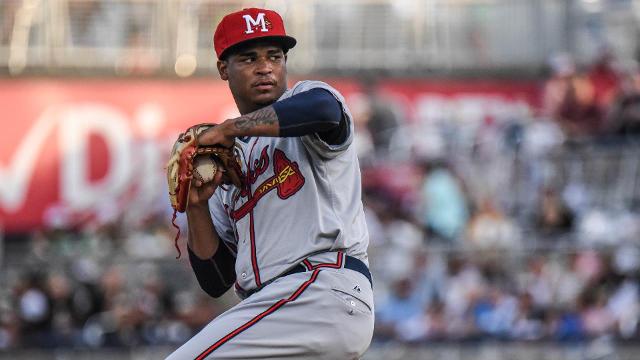
10. Jasseel De La Cruz, RHP
Age: 22 | Throws: R
3.25 ERA | 3.55 FIP | 25 G, 24 GS | 133.0 IP | 3.32 BB/9 | 8.19 K/9 (A/A+/AA)
Current Assignment: AA Mississippi
Acquired: International Amateur Free Agent – 2015
Prior Year Ranking: 31
Jasseel De La Cruz did more to improve his stock than perhaps any pitching prospect in the Atlanta Braves farm system during the 2019 season. After spending an injury-plagued 2018 at Rome, where he put together a 4.83 ERA, 4.41 FIP and 3.92 xFIP campaign with an elevated 4.4 walks per nine innings, he began 2019 at the same level where he showed immediate improvement with a 2.50 ERA and just five walks in eighteen innings over four starts, thereby earning a quick promotion to High-A Florida. De La Cruz was even better in that four-start stint with a 1.93 ERA and just seven walks in 28 innings, capped off by a no-hitter in his final start there. He then received a promotion to AA Mississippi where he spent the remainder of the season. At Mississippi, the overall numbers look don’t overly impressive with a 3.83 ERA, 4.11 ERA, a 4.16 xFIP and 3.8 walks per nine innings, but he showed consistent improvement throughout the season and walked just nine hitters total over his last seven starts and a 3.10 ERA over his last six starts once the organization started to decrease his workload to finish out the season.
De La Cruz has a mid-90s fastball that can touch a bit higher, a plus slider and an improving changeup in his arsenal and mainly needs more innings to prepare himself for the major leagues. As of now, he has pitched fewer than 300 innings in his professional career with 133 of those in 2019. He will begin 2020 heading the Mississippi rotation with the opportunity to move up to Gwinnett quickly depending on his performance and having a spot available. Now that he’s on the 40-man roster, De La Cruz could even conceivably make his way onto the Atlanta roster in September. -MC
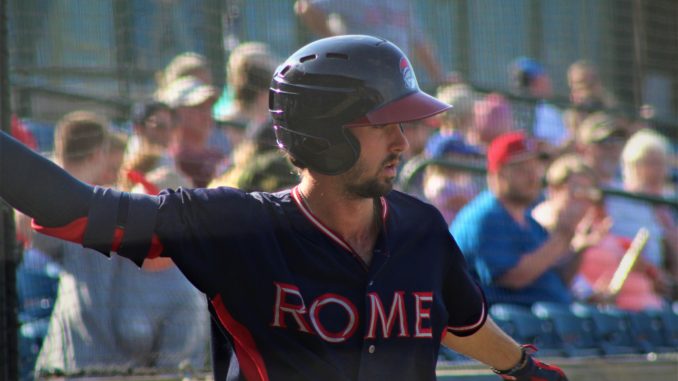
9. Braden Shewmake, SS
Age: 22 | Bats: L
.300/.371/.425 | 133 wRC+ | 3 HR | 13 SB | 9.0% BB | 14.4% K (A/AA)
Current Assignment: AA Mississippi
Acquired: Drafted, 1st Round – 2019
Prior Year Ranking: N/A
In the 2018 draft, the Braves went against type when they selected college outfielder Greyson Jenista in the second round, the highest they had picked a college position player since 2001. In the 2019 draft they doubled-down on this new strategy, using both of their first-round picks on college position players. The first went to Baylor catcher Shea Langeliers, and the second to Shewmake out of Texas A&M. Shortly after the selection, Braves VP of Scouting Dana Brown had this to say:
Braden is an athletic shortstop, and even though he’s a college guy, I think he has high upside with that loose, wiry frame he has. We think he’s going to put on some strength. We think he’s going to get to some power. He’s really good at the position and an average-to-plus defender. And what a lot of people don’t know is this guy can actually run. Definitely an above-average runner. It’s a nice package of upside, athleticism and power coming down the road for this young man.
At least in the short run, that evaluation has shown to be a good one, as Shewmake has shown all of those attributes. After going 0-for-3 in his pro debut with Rome, Shewmake immediately posted a 10-game hitting streak. After going .318/.389/.473 in 51 games with Rome, the Braves skipped him past advanced-A and gave him a taste of AA Mississippi, making him the first position player ever drafted by Atlanta to get to the AA level in his debut season. In 14 games with Mississippi, Shewmake predictably struggled with a .217/.288/.217 batting line.
Shewmake has a quick, smooth left-handed swing and he is comfortable going with the pitch to the opposite field. At 6’4″, Shewmake can hit for power when he goes down and gets hold of a mistake, but that isn’t a major part of his offensive game at the moment; it will be interesting to see if the Braves try to get him to tap into that power more. The pre-draft scouting that Shewmake would be a fringe defensive shortstop turned out to be underselling his ability; he shows good feel for the position, good hands, and a strong arm. If the Braves elect to make him a super-utility player, he has the arm for third and the athleticism for outfield. Shewmake has above-average speed and is a smart baserunner.
Shewmake seems to be on the fast train to Atlanta, but the move to AA was hyper-aggressive even for the Braves. While it seems unlikely that he would move back down to start at the advanced-A level he skipped in 2019, Shewmake should be given as long as he needs to master AA pitching. -AH
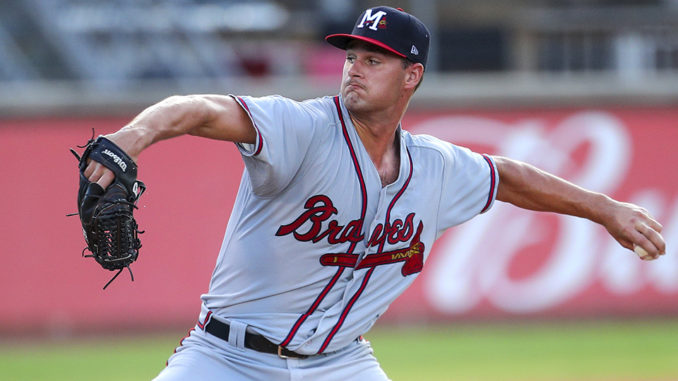
8. Kyle Muller, LHP
Age: 22 | Throws: L
3.14 ERA | 3.75 FIP | 22 G, 22 GS | 111.2 IP | 5.48 BB/9 | 9.67 K/9 (AA)
Current Assignment: AA Mississippi
Acquired: Drafted, 2nd Round – 2016
Prior Year Ranking: 11
Kyle Muller came off a standout 2018 campaign where he worked his way from low-A Rome to AA Mississippi and even a successful stint in the Arizona Fall League to begin 2019 at Mississippi with one of the highest set of expectations for any Braves pitching prospect. His season started off poorly from a command and control standpoint where he tallied just 8.2 innings over his first three starts, only allowing two hits and three earned runs while striking out fifteen, but also giving up fourteen walks and four wild pitches. His body of work improved somewhat after that, but the control issues never fully went away. May went much better for Muller with a 0.81 ERA, a .960 WHIP and 3.0 walks per nine over five starts. However, the control problems resurfaced in June along with an inability to keep the ball in the park with a 6.06 ERA, a 1.500 WHIP, 5.5 walks per nine and four home runs allowed in just 32.2 innings. Muller’s Jekyll-and-Hyde ways continued in July with a 2.03 ERA in five starts, albeit with 5.4 walks per nine and a 1.388 WHIP. Those numbers were mitigated by not giving up any home runs during the month. His season, however, ended on a down note after leaving his start on August 2nd with a right leg injury after just three pitches.
Kyle Muller’s pitching toolbox revolves around his mid-to-high 90s fastball, which is his best pitch. He also mixes in inconsistent off-speed pitches in a developing curveball, slider and changeup. His work at Driveline after the 2018 season helped increase the velocity and release point of his fastball, but now he must develop his secondary pitches to have a shot of making it as a mid-rotation starter at the MLB level. His current path is similar to that of a another left-handed prospect of recent vintage, Sean Newcomb, in that he doesn’t give up a lot of hits but a lot of walks, keeping the damage to a minimum through keeping the ball in the park in a pitcher’s league. The problem comes when he moves up to AAA and MLB with a different baseball and more homer-friendly parks where he won’t be able to cover up the mistakes so easily. -MC

7. William Contreras, C
Age: 22 | Bats: R
.255/.315/.354 | 98 wRC+ | 6 HR | 0 SB | 7.0% BB | 20.2% K (A+/AA)
Current Assignment: AA Mississippi
Acquired: International Amateur Free Agent – 2015
Prior Year Ranking: 6
When you see a guy who’s that athletic, the sky’s the limit on what he’s capable of. Hopefully we can start working on the discipline part, get him versed in our language we use, be it the blocking, catching and throwing, or the actual game-planning stuff, how to set up and game plan and work with pitchers. I think he’s got a really good aptitude and he’s willing to learn. So I’m excited to see what it’s going to be like.
– Sal Fasano, Atlanta Braves Catching Coach, Spring Training 2019
After starting to get national attention after a 2018 season in which he was one of the top hitters in the South Atlantic League and in which he got a promotion to advanced-A Florida, Contreras opened 2019 back in Florida with new marching orders — clean up the overall defensive game, as Fasano intimates in the quote above. Offense took a bit of a back seat, though he was an above average hitter in Florida before his mid-season promotion to AA Mississippi. Contreras seemed more timid at the plate in AA, a little more passive, and it sapped his overall production.
Behind the plate however, progress was made. Already possessing one of the top catcher arms in all of the minor leagues, Contreras continued to improve on his game calling, framing, blocking, and footwork; this progress was crystallized twice in 2020 when Contreras caught both Jasseel De La Cruz’s and Ian Anderson and Jeremy Walker’s no-hitters for Florida and Mississsippi respectively. Contreras is a natural leader and can be a fiery competitor on the field, similar to his brother, Chicago Cubs catcher Willson Contreras. At the plate, Contreras is best when he is aggressive against fastballs, using his bat speed and hands to go with the pitch. Contreras has good raw power that remains mostly untapped; catchers typically develop offensively a little slower than other positions, so it would be not surprising if he it takes another year or two to see Contreras start approaching his offensive ceiling.
Contreras should return to AA Mississippi, and he’s likely to spend most of the season there. That said, he is now on the 40-man roster, so a look in Atlanta at the end of the season (or even before then if they have an injury need) would also be likely. -AH
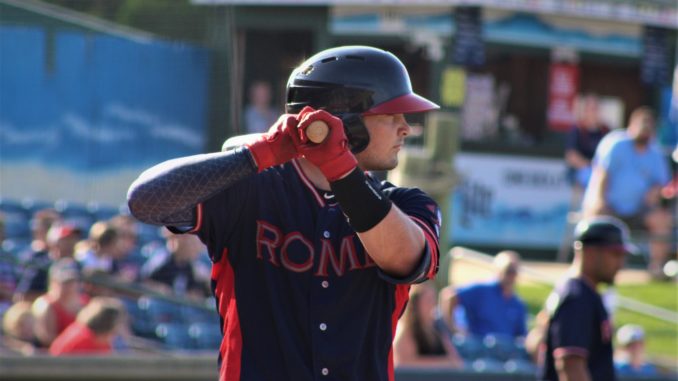
6. Shea Langeliers, C
Age: 22 | Bats: R
.255/.310/.343 | 92 wRC+ | 2 HR | 0 SB | 7.1% BB | 23.0% K (A)
Current Assignment: A Rome
Acquired: Drafted, 1st Round – 2019
Prior Year Ranking: N/A
There was a time when Langeliers was considered a possible first-overall draft pick, but the rise of Oregon State’s Adley Rutschman as the top overall catcher in the class coupled with a hamate bone break suffered by Langeliers in his junior year sabotaged those considerations. The Braves aren’t complaining though, as they were able to snag Langeliers with the 9th-overall pick, the first college position player selected by Atlanta in the first round in 18 years. Langeliers was slow to get going at the plate, not surprising considering that he was also learning a new pitching staff and calling his own games, but he warmed up down the stretch, hitting .308/.346/.385 over the final 29 games.
Langeliers was the top defensive catcher in the draft, and he showed advanced tools with Rome. Everything Langeliers does behind the dish is fundamentally sound, and he complements this with strong athleticism. This includes a plus-plus arm, and he cut down 16 of 23 would-be baserunners. At the plate Langeliers has a little farther to go, but he has a good approach and strike zone judgement. He shows good raw power, but a swing that for now is more geared for putting the ball in the gaps. At times he seemed to press, perhaps wanting to show worthy of the top 10 pick, but he clearly got more comfortable as the season progressed.
Look for Langeliers to start 2020 in advanced-A, and perhaps stay there all season barring an offensive breakthrough. Rushing catchers never tends to work out well for teams, and with free agent Travis d’Arnaud on the team through 2021 and Alex Jackson and William Contreras also in the organization, there isn’t a need for it. A 2022 debut though is certainly a possibility. -AH
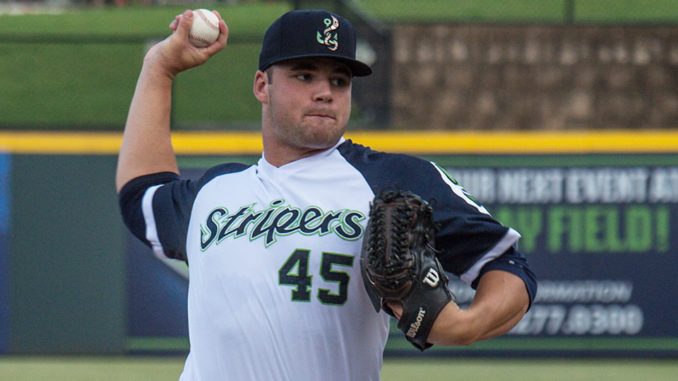
5. Bryse Wilson, RHP
Age: 22 | Throws: R
3.42 ERA | 3.68 FIP | 21 G, 21 GS | 121.0 IP | 1.93 BB/9 | 8.78 K/9 (AAA)
Current Assignment: MLB – Atlanta
Acquired: Drafted, 4th Round – 2016
Prior Year Ranking: 8
Wilson zoomed past fellow 2016 prep pitching draft picks like first-rounders Ian Anderson, Joey Wentz, and Kyle Muller in the 2018 season thanks to a rapidly improving fastball and command, leading to a surprise late-season promotion to Atlanta. Wilson followed that up with a strong spring training and an Opening Day rotation assignment at the ripe old age of 21 years old. Unfortunately, the Phillies abused him in that first start (as they did with pretty much the whole pitching staff), and Wilson was quickly returned to AAA Gwinnett. Wilson survived the heightened offensive environment of the 2019 International League and earned another shot at the Atlanta rotation, getting three mid-season starts in late June/early July. Wilson held his own despite uncharacteristically losing command on occassion. The Braves then acquired veteran Dallas Keuchel, and Wilson went back to AAA except for one September relief appearance. At AAA however, Wilson won the International League ERA title and made an All-Star appearance.
Wilson has two towering strengths when things are going well, a rising four-seam fastball that sits in the mid-90s well into games and the ability to place it where he likes. To take the next step however, Wilson needs to show more consistency with at least one of his secondary pitches. He throws a slider and a change-up, each of which has shown flashes of being a plus offering, but there’s too many days where he doesn’t have one or the other pitch. Wilson’s fastball is so good that he can lean on it too much, and at the majors all the hitters eventually will time the fastball if they see it enough. Wilson is an A+ competitor who doesn’t like to give in to hitters, a good approach if he gets a secondary working for him. He’s also athletic on the mound and moves well.
All of the ingredients are present for Wilson to take the next step and solidify a spot in a major league rotation. If there’s an opening at the major league level, Wilson should get another opportunity to seize the job. His stuff would also work as a high-leverage reliever, but he would likely have more value to the Braves has a trade candidate at that point. -AH
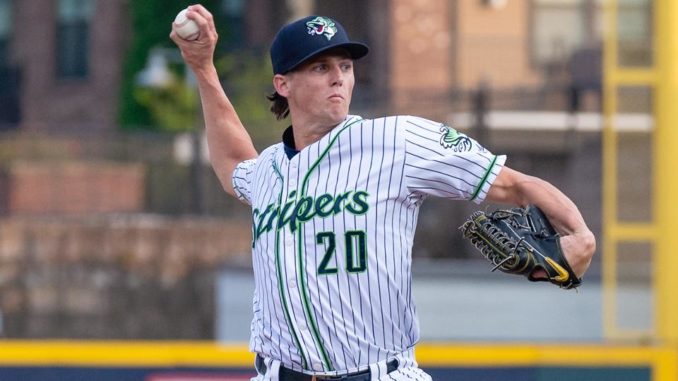
4. Kyle Wright, RHP
Age: 24 | Throws: R
4.17 ERA | 4.32 FIP | 21 G, 21 GS | 112.1 IP | 2.80 BB/9 | 9.29 K/9 (AAA)
Current Assignment: MLB – Atlanta
Acquired: Drafted, 1st Round – 2017
Prior Year Ranking: 9
After a solid 2018 divided between Mississippi, Gwinnett, and even the final month of the season in Atlanta, Kyle Wright was expected to start 2019 at Gwinnett. After just 161 professional innings, he just needed some more development time before he was ready to join the Atlanta rotation. However, due to injuries to Mike Foltynewicz and Kevin Gausman, he and Bryse Wilson were unexpectedly shoved into the opening day rotation. Wright started three games with mostly poor results before being optioned to Gwinnett on May 13th. During these three starts, he put up the following line: 14 IP, 15 H, 11 ER, 4 HR, 10 BB, 11 K with only a 6 IP, 2 ER start against the Marlins being a bright spot.
Once he was optioned, he suffered a fate shared by Bryse Wilson and Touki Toussaint as they were consistently riding the Atlanta-Gwinnett shuttle while having to alternate between starting and relieving roles. Wright was called up three more times in May and June for a total of eleven days…and never pitched. Due to the inconsistent roles and days between starts, his Gwinnett starts weren’t what was expected, either. In his first nine AAA starts, he had a 7.03 ERA in 39.2 innings, a 1.462 WHIP, walked 2.9 per nine innings and striking out just 6.8 per nine while going ten days between starts twice.
The proverbial switch, however, got flipped on June 14th and Wright had a terrific final 2 ½ months. During this period (with an MLB start on July 19th in-between where he gave up seven earned runs in 2.2 innings), Wright put up a 2.57 ERA, a 1.181 WHIP, 3.1 walks per nine innings and bumped up the strikeouts to 10.5 per nine while giving up just seven home runs in 73.2 innings. Wright got called up to Atlanta in September and, armed with renewed confidence and a 90-mph slider, gave up just one run in three relief innings while giving up just two hits and striking out four.
Kyle Wright’s pitches include a consistent upper-90s fastball, above-average curveball and changeup and an improving hard slider, which might be the key to his success in MLB as was seen in September. There’s not much left to accomplish at AAA for Wright and there’s a pretty good chance he’s at the back end of the rotation to start 2020 in Atlanta. If he does go back to Gwinnett, it will only be because there’s a logjam at the MLB level. -MC
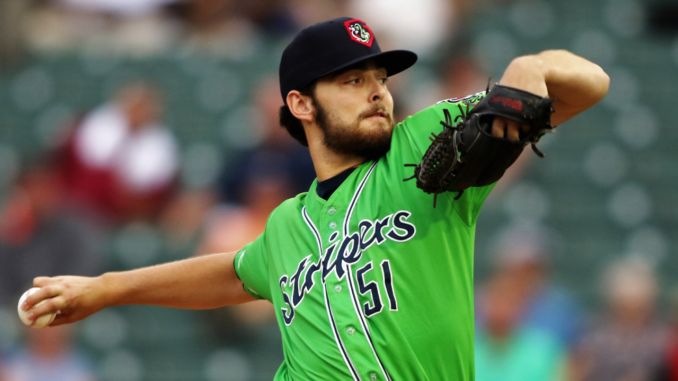
3. Ian Anderson, RHP
Age: 21 | Throws: R
3.38 ERA | 3.55 FIP | 26 G, 26 GS | 135.2 IP | 4.31 BB/9 | 11.41 K/9 (AA/AAA)
Current Assignment: AAA Gwinnett
Acquired: Drafted, 1st Round – 2016
Prior Year Ranking: 5
Ian Anderson began 2019 at the head of the Mississippi rotation after spending most of 2018 at Florida where he entrenched himself among the top prospects in the Atlanta Braves organization. He got off to a bit of a slow start in his first four outings, giving up thirteen walks and nine earned runs in his first seventeen innings before tossing a couple of scoreless six-inning starts. After two more rough outings, Anderson went on a tear beginning May 19th through his last Mississippi start at the end of July. During this stretch of 13 starts, he put together the following numbers: a 2.03 ERA, a 1.049 WHIP and struck out 11.5 hitters per nine innings while walking just 2.7 per nine. He also gave up more than two earned runs in a start just once during this period. His best start during this run was in a combined no-hitter on June 28th at home vs. Jackson where he struck out fourteen and walked just two before giving way to Jeremy Walker to finish it off. This stretch got him promoted to Gwinnett in early August, where he found trouble adjusting both to the level of competition as well as the AAA/MLB baseball. In five starts, Anderson put together a 6.57 ERA, a 6.42 FIP and a 5.93 xFIP with eighteen walks and five home runs allowed in just 24.2 innings after giving up just eight home runs in 111 innings at Mississippi.
Anderson’s Mississippi numbers, including a .199 batting average against, a 1.16 WHIP and 147 strikeouts (third in the Southern League and led the league at the time of his promotion) helped earn him a number of season-ending awards, including 2019 Minor League Pitcher of the Year from the Braves organization, sharing 2019 Mississippi Braves Pitcher of the Year with Tucker Davidson and Braves 2019 Minor League Player of the Year from Baseball America.
Anderson’s arsenal consists of a fastball that can stay consistently in the mid-90s, an above-average curveball and an improving changeup. He’ll begin 2020 among the top starters in the Gwinnett rotation, needing primarily to hone his command with the AAA/MLB baseball. Once he does that, he should get the call to Atlanta sometime during the season. If Anderson can keep the walks below four per nine innings, he can be a very good MLB pitcher. If he can get the walks below three per nine as he did during that 13-start stretch in Mississippi, he can put himself among the top tier of starting pitchers in MLB. -MC
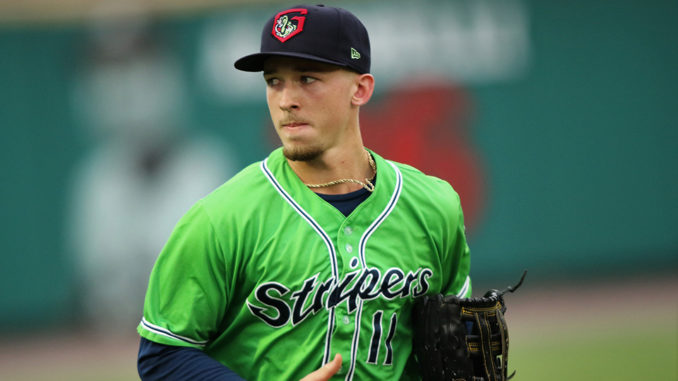
2. Drew Waters, OF
Age: 21 | Bats: S
.309/.360/.459 | 132 wRC+ | 7 HR | 16 SB | 6.8% BB | 28.6% K (AA/AAA)
Current Assignment: AAA Gwinnett
Acquired: Drafted, 2nd Round – 2017
Prior Year Ranking: 7
Drew Waters has been on a consistent upward trajectory in our rankings since being drafted in 2017, from #22 in 2017 to #7 in 2018 to #2 on this list. After a dominant 2018 at Rome (145 wRC+), he was promoted to High-A Florida late in the season where he put together a .700 OPS and a 98 wRC+ in 30 games. It was expected he would start 2019 back in Florida but in a somewhat surprising move, he was promoted to Double-A Mississippi to start the season. Any concerns about this jump proved to be unfounded as Waters tore through the Southern League to the tune of a .319/.366/.481 batting line, a 144 wRC+ and 49 extra-base hits in just 454 plate appearances. He earned a promotion to Gwinnett in early August where the numbers weren’t quite at that level with a .271/.336/.374 line, a 98 wRC+ and a 36% strikeout rate. Based on his Mississippi numbers, though, Waters earned Southern League Most Valuable Player honors and a league batting title while sharing Mississippi Player of the Year honors with Cristian Pache.
Drew Waters is a true five-tool player: although his defense and arm are overshadowed by that of Cristian Pache, he can more than hold his own in any outfield spot. He can fly on the basepaths and isn’t afraid to show it, such as trying to score from second base on a fly out to the outfield. He isn’t a particularly efficient base-stealer though, as he was just 16-for-22 (73%) in that department. The power isn’t translating to home runs at this point as potential long balls turned into deep outs, doubles and triples in pitcher-friendly Trustmark Park. Another point that needs to be brought up about Waters is his high batting average on balls in play, he had BABIPs of .436 at Mississippi and .427 at Gwinnett. Although his BABIP was unusually high in 2019, the lowest BABIP he has had at any minor-league stop is .362 and he has had a BABIP of over .400 for four of his six minor-league teams. Waters uses the entire field (43% pull, 22% middle, 35% opposite field at Mississippi) so he will always have a high BABIP but not necessarily in the .400+ range.
Waters will enter 2020 as a starting outfielder at Gwinnett to work on two areas: cut down on the strikeouts and develop more power from the right side.
These were Waters’ numbers from each side of the plate in 2019:
- As LHH: .325/.380/.486, 7.5% BB rate, 27.7% K rate, 6 HR in 440 PA
- As RHH: .258/.293/.371, 4.5% BB rate, 31.6% K rate, 1 HR in 133 PA
It should be noted that the only home run Waters hit from the right side was not until August 31st.
Drew Waters is a player that thinks he can accomplish anything on a baseball field and plays like it, always striving for an extra base, going all out on defensive dives and trying to make throws that shouldn’t necessarily be attempted. He’s the kind of guy fans will love if he’s on their team and hate if he isn’t. For all the Braves’ opponents (and some fans) that think Ronald Acuña is a player they dislike because of his “attitude”, Drew Waters is the player they think Acuña is. -MC

1. Cristian Pache, OF
Age: 21 | Bats: R
.277/.340/.462 | 126 wRC+ | 12 HR | 8 SB | 8.0 BB% | 22.7 K% (AA/AAA)
Current Assignment: AAA Gwinnett
Acquired: International Amateur Free Agent – 2015
Prior Year Ranking: 4
After a 2018 season that saw marked improvement at the plate between high-A and AA, Pache exhibited even more growth in 2019 as his production started to match his projections. Pache was one of the most potent offensive forces in the Southern League, hitting .278/.340/.474 in his 104 games with Mississippi which put him in the top 10 of the league in weighted runs created. After some brief struggles upon being promoted to AAA Gwinnett in August, Pache got hot down the stretch, hitting .365/.400/.596 in the final two weeks of the regular season and homering in Gwinnett’s only postseason win.
Pache continues to add muscle mass to his 6′-2″ frame, and this season he has able to consistently hit for power without over-swinging has he had the habit of doing the prior couple of years. Pache has the bat speed to catch up with nearly any fastball, and the increased walk rate was a welcome development. Still, Pache goes to the plate looking to swing the bat, and can go through some prolonged strikeout binges. One aspect of the game that is always consistent is his defense, and he remains the top defensive player in the Braves system; if promoted to Atlanta, he should start everyday even if he initially struggles at the plate because his centerfield defense is game-altering.
Even with his offensive breakout, Pache still can do more with experience, and he’ll likely get that for at least a little while back at Gwinnett. Ideally Pache will play his way onto the Atlanta roster at some point in 2020, and it doesn’t take too much imagination at this point to see a wildly athletic Waters/Pache/Acuña Atlanta outfield, perhaps as soon as the end of 2020 if the team has the guts to try it. -AH



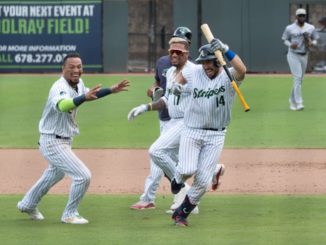
Leave a Reply